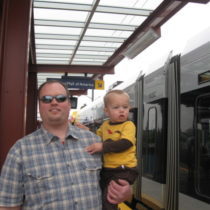Landscape Architecture for Landscape Architects › Forums › RESEARCH › Developing Community and healthy Relationships
- This topic has 1 reply, 3 voices, and was last updated 14 years, 1 month ago by
 Jordan Lockman.
Jordan Lockman.
-
AuthorPosts
-
November 2, 2011 at 5:39 pm #159525
 Ryan SandParticipant
Ryan SandParticipantWith Urban Design constantly reworking the landscape of the city, I have begun research on what creates a healthy city after you have established the landscape. I would point to community gardens as one of the first examples where a landscape function is established followed by a community beginning to relate and develop. Such aspects of a truely healthy community include; safety and security, health, well-being of children, environmental stewardship, entrepreneurship, and care.
While a park can be a catalyst there are steps that will truly establish these aspects. One recent statistic I found was that if you know the names of all your neighbors security can go up by 35%. Another is people with the fewest social ties had the higher risks of dying from heart disease, circulatory problems, and cancer; this means that to have relationship with your neighbors can add years on your life! I am looking for these hard facts as well as historically documented stories encouraging investing in a community relationship.
Aid me as this will change professional practice. While we encourage that a park will build a better community we must also begin to understand that the people have a good bulk of the power to create their own better world as well!
My research has been launched from reading the book: “abundant community: awakening the power of families and nieghborhoods”
November 3, 2011 at 3:34 pm #159527 Jordan LockmanParticipant
Jordan LockmanParticipantI live in a suburb our small nieghborhood was built in the early 70’s and we are surrounded by houses built in the 80’s and 90’s. 3/4 of our neighborhood is “originals” that built the neighborhood together. They are rightfully really close, built houses, raised kids, vacation, mourn, and celebrate together. Us 2nd/3rd neighborhood generation people formed our own clique of new folks with kids. Neighborhood fires, trick or treating, zoo trips, pumpkin carving contest, etc. What made this happen is personalities and people.
So how does design encourage this?
I struggle with starting associations, these create enemies in my experience, there is some value to small groups owning a small park together with little or no association responsibilities or dues. The neighboring neighborhood is on a lake and that neighborhood owns a private park/marina together and seems fairly functional. Anything beyond that breeds bad blood, sometimes there are nieghbors it is good not to know.
Neighborhood parks. We have two and this is great if your kids are between the ages of 2 and 8 so a very small portion of the neighborhood.
Community schools and sports teams****** Very important. Especially when there is a strong PTA/PTO this is a great place for community identity/education. Just remember that kids having a time and place to be kids is a great way for this community to develop.
Neighborhood churches. I have found many of the advantages of the above at the church also. It is a smaller neighborhood church so there is the community identity all in it together attitude. Really like that.
Neighborhood sledding hill, ice rink, baseball field, basketball court, walking paths, are all places where I interact with new neighbors. National night out/night to unite also a great catalyst.
Community Garden, joined one of these near my office and guess what another great place to interact with community. Especially when part of the produce is made in service to others. Just planted my garlic for the food shelf.
The most important is having the right mix of people and getting them to connect, how can you plan to accomplish that?
For me it is smaller pockets of mixed uses. Have some room for a mixture of uses. Get people out of cars and on foot. So they can say hello, how is the dog, baby, garden, whatever.
Can they walk to church, cornerstore, park, school, sledding hill, bike paths, etc.
November 3, 2011 at 10:23 pm #159526 Tosh KParticipant
Tosh KParticipantOne of the major failures of Modernist architecture was its dogmatic faith in design being able to solve social issues by controlling behavior. That being said, one could help facilitate community interaction, the design centers popping up in every large city seems to provide a forum for interaction relative to the built environment. I would encourage you to look into the writings/research coming out of UC-Berkeley’s program as they have been rigorously looking into the social implications of design (notably Randy Hester’s book on ecological democracy), medical journals carry a lot of studies of public health and urban design, cultural geographers have documented and analyzed a range of “communal” spaces. Simon Shama’s Landscape and Memory is a good read as well.
Do note that many parks have encouraged/harbored illicit activities, the importance of a strong engaged relationship between community and its public spaces cannot be overlooked.
One way to look at is for facts and metrics, another is to challenge the world view (Timaeus -Plato, Building Dwelling Thinking – Heidegger, Space and Place -Yi-Fu Tuan). I personally find the normative western thought to be limiting in conducting research on ‘meaningful places’, the aforementioned world view is better suited for the research of ‘valuable spaces.’
Also important to note the writings and research relevant to social trends – we live in a time when select social groups have become mobile with that mobility changes social dynamics, esp in context of larger urban centers.
-
AuthorPosts
- You must be logged in to reply to this topic.


